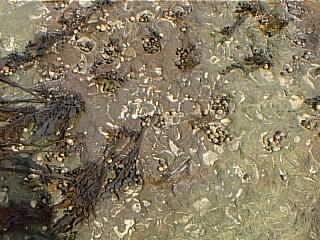| Group | Stage | Formation | Member |
|---|---|---|---|
| LIAS | Pliensbachian | Staithes Sandstone | |
The Staithes Sandstone Formation is generally a 30m thick argillaceous silty sandstone with 2 to 4m thick sequences of cleaner fine-grained laminated sandstone in the middle and upper parts. It is typically intensely bioturbated and/or showing bedding structures of many types.
On the upper boundary there is a gradual transition from sandstone/siltstone to the shaly mudstone with scattered Sideritic nodules of the Cleveland Ironstone Formation.
The lower boundary is gradational with the underlying mudstones of the Redcar Mudstone Formation, but is taken for consistency at the base of the "Oyster Bed", a fossiliferous calcareous and ferruginous sandstone packed with the bivalves Gryphea gigantea, Oxytoma inaequivalvis and Pseudopecten aequivalvis. This layer appears to persist as a continuous horizon throughout the Cleveland Basin.

Brachiopod forms preserved by Diagenesis in the Lower Lias Clay
Image by John Vincent dated: July, 2004
Sandstone packed with bivalves at the junction between the Staithes Sandstone Formation and the Redcar Mudstone Formation